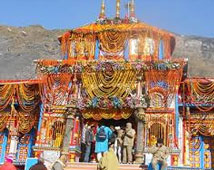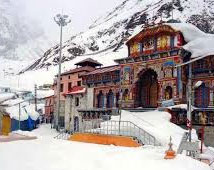
Cradled in the twin mountain ranges of Nar and Narayan is the holiest of the four main shrines, Badrinath along the left bank river Alaknanda. With the splendid Neelkanth mountains as the backdrop, it is an important destination on the scared itinerary of every devour Hindu. Once the spot was carpeted with 'badris' or wild berries and hence was famous as 'Badri Van'.
Badrinath is considered the holiest of the four important shrines in Garhwal. The town is at an altitude of 3,133 m. above sea level, situated on the left bank of river Alaknanda and exactly between the two mountains Nara and Narayan. The shrine is dedicated to Vishnu, the preserver and falls in the religious itinerary of every devout Hindu.
The present temple was built about two centuries ago by Garhwal Kings. It is a conical structure, 15 m. tall and has small cupola of a gilt bull and spire. There are 15 idols in the temple complex, each sculpted in black stone. The principal idol represents Vishnu in a meditative posture and is flanked by Nara-Narayan.
Legend dates it prior to the Vedic age though it is believed to have been re-established by Adi Shankaracharya, an important Hindu saint in 8th century A.D. Some of the other images include Laxmi (Vishnu's consort), Garud (Vishnu's mount), Shiva & Parvati and Ganesha.
The temple has been renovated several times due to damages by avalanches. It looks fairly modern now due to the colourful "Singh Dwara" or the main entrance gate. It has three parts- Garbha Griha (the sanctum sanctorum), Darshan Mandap (for pujas) and Shobha Mandap (for devotees to assemble).
The revered shrine is still alive with myriad legends from mythology. Its sanctity is emphasised in the ancient scriptures as "There are many sacred spots of pilgrimage in the heavens, earth and the nether world, but there has been none equal to Badri, nor shall there be".
Besides the main temple of Badrinath there are four other smaller badri temples. These are collectively called the panch badris or five badris. Very few pilgrims however, visit the other four Badri temples.

Yogadhyan Badri (1920 m.)
Closest to the main temple of Badrinath lies this tiny, sleepy hamlet which remains unnoticed by most pilgrims and is the winter home for the idol at Badrinath. Pandukeshwar is also an important archaeological site. Some years ago, four ancient metal foils engraved with a description of several kings in the region were discovered here. Believed to be over 1500 years old, these foils are kept at Joshimath, 30 km downstream.
Bhavishya Badri (2,744 m.)
The bhavishya or future badri is situated at Subain near Tapovan, about 17 km east of Joshimath. According to Hindu belief, when evil is on the rise in this world, the two mountains Nara and Narayan at Badrinath will close up on each other and destroy the route to the present Badrinath. This would also mark the end of the present world and the beginning of a new one. Lord Badrinath will then appear at the Bhavishya Badri temple and be worshipped here instead of at the present one.
Bridha Badri or the 'Old Badri'
Bridha Badri or the 'old Badri' is the third temple about 7 kms short of Joshimath, on the main Rishikesh-Badrinath motor road at Animath. It is believed that Badrinath was worshipped here before its enshrinement by Shankaracharya at the main Badrinath seat. The temple of Bridha Badri is open throughout the year.
Adi Badri
Adi Badri is the farthest from the other four badris. It is approachable from Karnaprayag by a motorable road enroute Ranikhet. The temple complex has 16 small temples with intricate carvings.